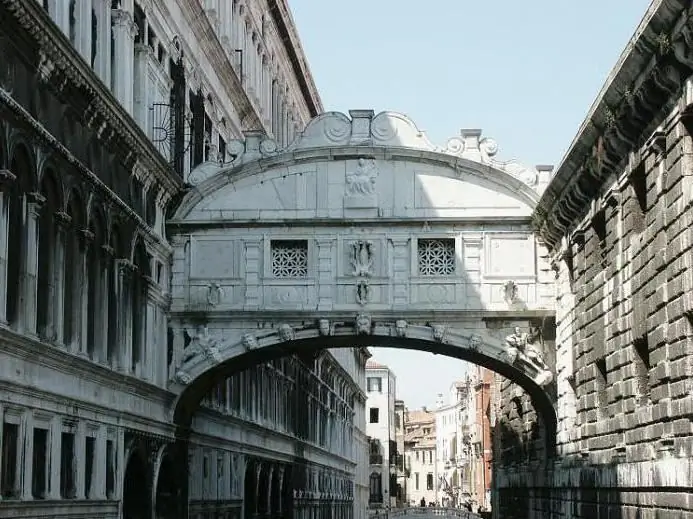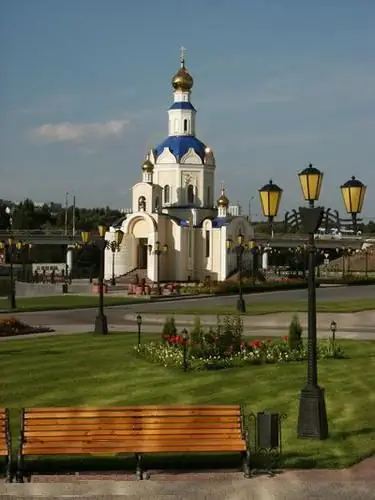- Author Harold Hamphrey [email protected].
- Public 2023-12-17 10:06.
- Last modified 2025-01-24 11:10.
Paris is a city with a glorious centuries-old history, famous for its magnificent monuments of culture and architecture. In this article, we will introduce you to the Parisian residence of the head of state. The Elysee Palace is closed throughout the year to the general public. Only in September, on one of the weekends, Parisians and guests of this city are given the opportunity to inspect some of the premises of the magnificent building.

The Elysee Palace in Paris is the main state building, a symbol of the country's supreme power, the standard of French classicism. It is separated by dense greenery from the famous Champs-Elysées and by a high wall from Rue Saint-Honoré. This building, famous for its architecture and playing a special role on the historical stage, has never occupied such an exclusive place that is assigned to the Louvre, Versailles or the Tuileries. Nevertheless, he was and will always remain one of the mostsignificant architectural monuments of France.
Location
Elysee Palace is located next to the famous Champs Elysees. It is a municipal property and a landmark of Paris. Every traveler arriving in the country wants to see the Elysee Palace. Its address is Rue Saint-Honoré, house 55. This is the VIII arrondissement of Paris.
Historical background
In 1718, Count Evreux ordered the construction of a mansion, which was led by the architect Claude Mollet. Construction work continued for four years. As a result, a magnificent majestic building, made in the style of the French Regency, appeared in the capital of France.
On one side (from the Champs Elysees) a beautiful garden has been created with various kinds of shrubs, flowers and trees. On the other hand, the territory of the palace is limited by Saint-Honoré street.

The owners of the palace
After Count Evreux left this world, the mansion was bought from his relatives by King Louis XV. He presented it as a gift to Madame de Pompadour - his favorite. She subsequently bequeathed it to the king's relatives. Ownership passed to them in 1764.
Together with his retinue, Louis XVI arranged sessions of black magic and spiritualism in the palace. Then the banker Beaujon became the owner of the luxurious building. He made some changes to the layout of the palace - under him a painting gallery appeared here.
The next owner of the legendary building was the Duchess of Bourbon. Marshal Murat completed the list of private owners of the palace.
Governmentbuilding
After the coup d'etat that brought Napoleon I to power, the Elysee Palace was first used as a government building. However, it received the status of an official government residence under Louis Napoleon Bonaparte in 1848.
It must be said that Napoleon III did not work and did not live in the palace. He preferred apartments in the Tuileries. However, it was he who initiated the biggest changes and reconstructions in the palace. They were held from 1853 to 1867. The world famous architect Lacroix supervised the work. During this period of time, the Elysee Palace acquired the characteristic features of the French classics. In this form, he appears before tourists today.

Restoration and repair work is systematically carried out here, new elements are introduced into the interior, but the general style of the building is strictly observed.
Description
Photos of the Elysee Palace often grace the covers of glossy publications, so those who have never been to the French capital have a general idea of this magnificent building. The palace was built in accordance with the tastes and requirements of its era. It is a characteristic example of classicism.
The three-story central building is separated from the street by a semi-circular courtyard closed on all sides. On the other side of it (from the Champs Elysees) there is a park. In the depths of it are the "Gate of the Rooster". They got such a strange name because of the figure of the Gallic rooster (gilded) located above the forged arch. Since ancient times thissymbol of France.

The gate was created by Adrian Chansel during the years of the Third Republic. Today it is the main entrance to the territory, intended for officials. From the side of Avenue Gabriel and the Champs Elysees there is another main entrance. It is used for meetings of kings, presidents, as well as the Pope. From Rue Saint-Honore, you can look at the facade of the building. Unlike the "Gate of the Rooster", this entrance to the palace is working. It is used by the President of the country.
Elysee Palace in Paris: interiors
We have already said that there is no permanent access to the presidential palace for tourists. However, anyone who really wants to see its interior can do so on one of the weekends in early September. At this time, very detailed excursions are also not conducted here, but experienced French guides will show you and tell you about some halls and rooms of the palace.
As a rule, the main premises of the palace, the personal office of the president, located in the Golden Salon, are of great interest to tourists. This is an interesting room, decorated with unique tapestries, carpets and furniture in the Baroque style, paintings on the walls and ceiling, luxurious furniture in the Baroque style. Undoubtedly, such an office, thanks to its luxurious decoration, is worthy of a king.

Ceremonial Hall
In accordance with protocol, the President of France greets heads of state who are visiting the Elysee Palace in the lobby. The ceremonial hall is decoratedusing white Carrara and Belgian red marble. It is illuminated by a magnificent gilded bronze chandelier.
Arman's sculptural composition - "The Reward of the French Revolution" is reflected in the central mirror. It consists of 200 white marble flags on gilded bronze flagpoles.
Palace salons
The Pompadour salon is decorated with a large portrait of the king's favorite. Today, meetings of the Council of Ministers are held here every Wednesday. Meetings are held at a huge table that occupies almost the entire room. The President and Prime Minister sit opposite each other. Between them there is a watch with a double dial made of yellow brass, which allows the first persons of the country to check the exact time at the same time.

Murat's living room
In the living rooms of the palace, the President of France receives ambassadors, representatives of foreign states and other officials. The palace is secured by Republican Guard soldiers.
In Murat's living room on the walls are hung images of Napoleon I's brother-in-law - Joachim Murat, made by Horace Vernet. The furniture in this most famous room of the palace dates back to 1819. There is also an old bureau behind which Emperor Napoleon wrote his abdication.
In addition to these rooms, tourists will be able to see some other chambers that have witnessed important historical events. François Mitterrand's dining room, the Silver Room, the President's office - each of these spaces will amaze guestsmagnificent decoration and sophistication.
If you plan to visit the Elysee Palace in early September, check with the tour operators for opening hours (excursions). In addition, almost every hotel will be able to provide you with such information.

Elysee Palace in Paris: interesting facts
Not everyone knows that in the basement of the palace is the holy of holies of France, where no tourist can ever get. We are talking about the cabinet of Jupiter, from which the president of the country can activate the nuclear forces of France.
Here are three television screens that provide direct communication between the President, the Strategic Air Command and the Secretary of Defense.
An interesting fact: according to the approved protocol at the “main table” of France, 60 cm is allocated for each guest.
All dining utensils of the palace are specially kept. She has a separate room. It contains 35 wooden chests. In them, as well as in special leather boxes and containers, dishes are stored.
The duties of the chef of the Elysee Palace include maintaining a card index of the menu. This is necessary to avoid repetition of dishes for visitors to the palace who dined here not for the first time. By protocol, lunch cannot last longer than sixty-five minutes.
Not everyone knows that on the Avenue Marigny, which stretches along the eastern side of the palace in 1848, livedAlexander Herzen. Here he wrote Letters from Avenue Marigny.






